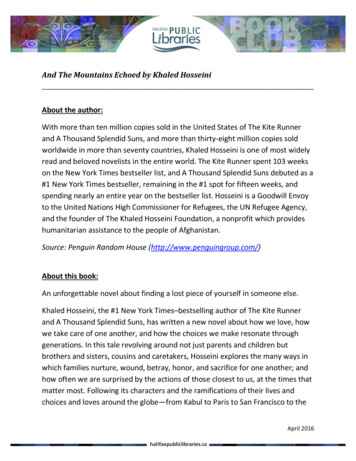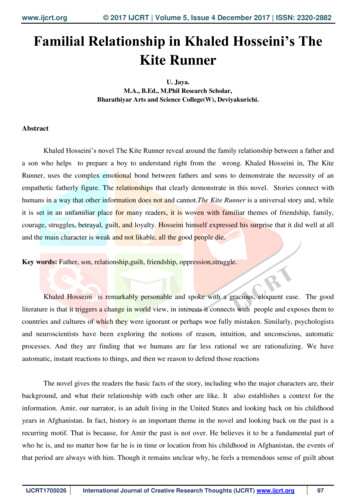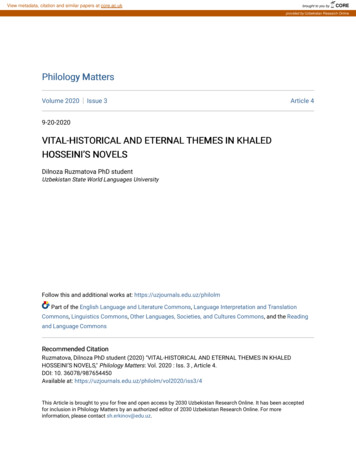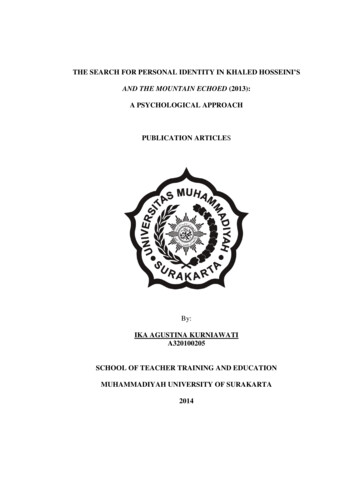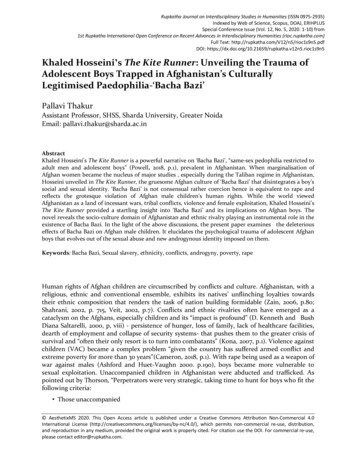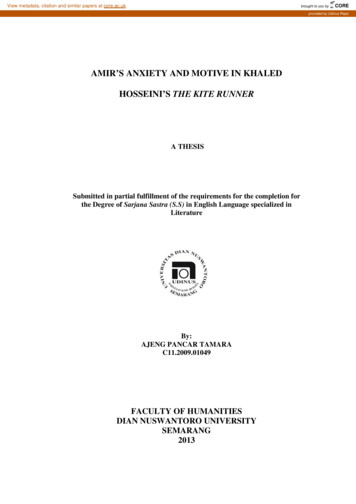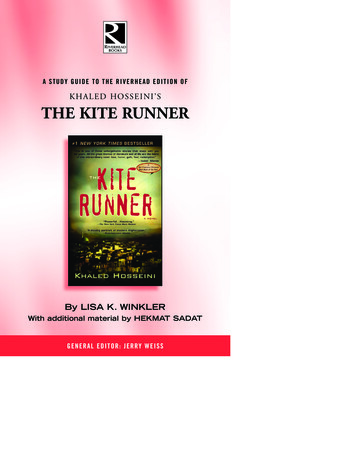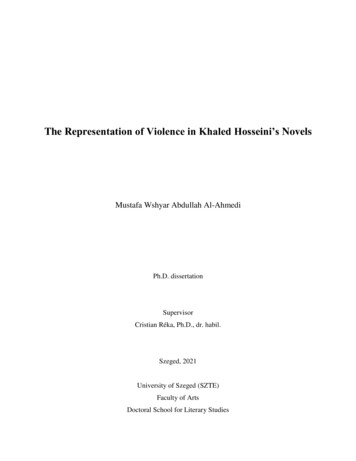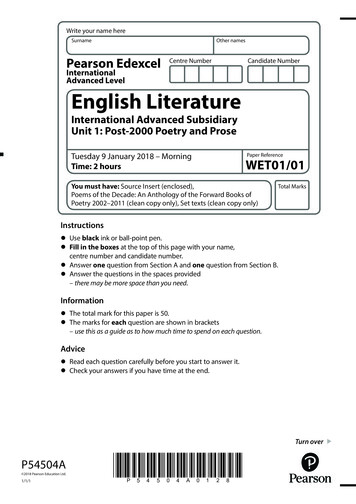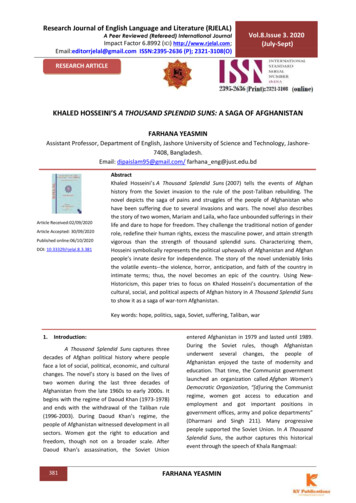
Transcription
Research Journal of English Language and Literature (RJELAL)A Peer Reviewed (Refereed) International JournalImpact Factor 6.8992 (ICI) http://www.rjelal.com;Vol.8.Issue 3. 2020(July-Sept)Email:editorrjelal@gmail.com ISSN:2395-2636 (P); 2321-3108(O)RESEARCH ARTICLEKHALED HOSSEINI’S A THOUSAND SPLENDID SUNS: A SAGA OF AFGHANISTANFARHANA YEASMINAssistant Professor, Department of English, Jashore University of Science and Technology, Jashore7408, Bangladesh.Email: dipaislam95@gmail.com/ farhana eng@just.edu.bdArticle Received:02/09/2020Article Accepted: 30/09/2020Published online:06/10/2020DOI: 10.33329/rjelal.8.3.381AbstractKhaled Hosseini’s A Thousand Splendid Suns (2007) tells the events of Afghanhistory from the Soviet invasion to the rule of the post-Taliban rebuilding. Thenovel depicts the saga of pains and struggles of the people of Afghanistan whohave been suffering due to several invasions and wars. The novel also describesthe story of two women, Mariam and Laila, who face unbounded sufferings in theirlife and dare to hope for freedom. They challenge the traditional notion of genderrole, redefine their human rights, excess the masculine power, and attain strengthvigorous than the strength of thousand splendid suns. Characterizing them,Hosseini symbolically represents the political upheavals of Afghanistan and Afghanpeople’s innate desire for independence. The story of the novel undeniably linksthe volatile events--the violence, horror, anticipation, and faith of the country inintimate terms; thus, the novel becomes an epic of the country. Using NewHistoricism, this paper tries to focus on Khaled Hosseini’s documentation of thecultural, social, and political aspects of Afghan history in A Thousand Splendid Sunsto show it as a saga of war-torn Afghanistan.Key words: hope, politics, saga, Soviet, suffering, Taliban, war1.Introduction:A Thousand Splendid Suns captures threedecades of Afghan political history where peopleface a lot of social, political, economic, and culturalchanges. The novel’s story is based on the lives oftwo women during the last three decades ofAfghanistan from the late 1960s to early 2000s. Itbegins with the regime of Daoud Khan (1973-1978)and ends with the withdrawal of the Taliban rule(1996-2003). During Daoud Khan’s regime, thepeople of Afghanistan witnessed development in allsectors. Women got the right to education andfreedom, though not on a broader scale. AfterDaoud Khan’s assassination, the Soviet Union381entered Afghanistan in 1979 and lasted until 1989.During the Soviet rules, though Afghanistanunderwent several changes, the people ofAfghanistan enjoyed the taste of modernity andeducation. That time, the Communist governmentlaunched an organization called Afghan Women’sDemocratic Organization, “[d]uring the Communistregime, women got access to education andemployment and got important positions ingovernment offices, army and police departments”(Dharmani and Singh 211). Many progressivepeople supported the Soviet Union. In A ThousandSplendid Suns, the author captures this historicalevent through the speech of Khala Rangmaal:FARHANA YEASMIN
Research Journal of English Language and Literature (RJELAL)A Peer Reviewed (Refereed) International JournalImpact Factor 6.8992 (ICI) http://www.rjelal.com;Vol.8.Issue 3. 2020(July-Sept)Email:editorrjelal@gmail.com ISSN:2395-2636 (P); 2321-3108(O)She said that Soviet Union was the bestnation in the world, along with Afghanistan.It was kind to its workers, and its peoplewere all equal . . . And everyone inAfghanistan would be happy too, she said,once the antiprogressives, the backwardbandits, were defeated. (Hosseini 111)However, most of the women were deprived of thiskind of empowerment. Moreover, “[t]he Sovietsoldiers molested rural Afghan women, and thisaggravated the flames of resistance against theSoviets” (Dharmani and Singh 211). In 1992 theMujahedeen sized the power and curtailed thehuman rights of women, “[t]he constitution wasabolished. The country witnessed the civil war asdifferent ethnic groups fought for power” (211).The socio-political scenario of Afghanistan changeddrastically.The factional fighting that took place from1992 to 1994 left parts of Kabul looking likeLondon after the Blitz. According to ICRCbetween 20000 and 30000 civilians died andthousands more injured. The fighting wasfuelled by ethnic and sectarian hatred andmarred by atrocities including massexecutions, rape, torture, looting andindiscriminate bombardment of residentialareas. (Lee 627)After the Civil war, the Taliban took hold of thepower and controlled the state imposing theirbrutal rules. In the name of religion, they reinforcedinhuman rules to protect the so-called tradition.They brought the country into a disaster withextreme fundamentalism. “On capturing Kandahar,Taliban did not lose much time in imposing theirself-interpreted version of Islam” (Fatima 36), theystarted new Sharia law and banned television andmusic. Hence, referring to the Taliban flyers, KhaledHosseini in this novel makes a travesty that religionis no more under the control of God, rather iscontrolled by the tyrants:Our watan is now known as the IslamicEmirate of Afghanistan. These are the lawsthat we will enforce and you will obey:382All citizens must pray five times a day. If it isprayer time and you are caught doingsomething other, you will be beaten.All men will grow their beards . . .All boys will wear turbans . . .Singing is forbidden.Dancing is forbidden.Playing cards, playing chess, gambling, andkite flying are forbidden. Writing books,watching films, and painting pictures areforbidden.If you keep parakeets, you will be beaten.Your birds will be killed.If you steal, your hand will be cut off at thewrist. If you steal again, your foot will be cutoff. (Hosseini 270)The Taliban enforced many inhuman decrees andcompelled people to follow them. Scared of beingpunished for trivial cause, people preferred stayingat home and became virtually estranged. Becauseof the vicious rules of different regimes, the peoplelost their hope and accepted their deplorable fate.Many left Afghanistan, but those who did not haveenough resources had to endure their fate. Theylead a life of poverty, hunger, fear, torture, andpunishment. The Taliban showed their realintention attacking the U.S. in 2001. After the U. S.declared a counter-attack supporting theMujahedeen against the Taliban, the booms,rockets, explosives crushed the country once again.However, the people of Afghanistan with the hopefor a better future worked for rebuilding thecountry. The novel recaptures all these historicalevents and also ends with a tone of positivity, thatis, Laila comes back to Afghanistan, and with Tariqand Zaman, she rebuilds the orphanage whichsymbolizes the renovation of the country. In thisnovel, Hosseini documents the authentic picture ofAfghan history by showing the intense effects ofthe political conflicts on the life of the characters.Using new historicism, this paper attempts to readA Thousand Splendid Suns as a re-vision of theAfghan history a saga of Afghanistan.FARHANA YEASMIN
Research Journal of English Language and Literature (RJELAL)A Peer Reviewed (Refereed) International JournalImpact Factor 6.8992 (ICI) http://www.rjelal.com;Vol.8.Issue 3. 2020(July-Sept)Email:editorrjelal@gmail.com ISSN:2395-2636 (P); 2321-3108(O)2.Theoretical FrameworkAs literature is related to the social,cultural, and political surroundings, we cannot readliterature in isolation. New historicism is a literaryapproach that deals with the relation betweenliterature and history, and advocates “the parallelreading of literary and non-literary texts, usually ofthe same historical period” (Barry 167). It refuses “aliterary ‘foreground’ and a historical ‘background’”(167) and sees “literature as contributing to,informing, influencing and participating actively inthe construction” (Nayar 203) of social, political orhistorical contexts. It is an equal reading of text andco-text. New historicists focus primarily on thesocial, historical, and cultural conditions of aliterary text as well as the how a literary textreflects, reproduces, or reinforces theseconditions—“‘the textuality of history, thehistoricity of texts’” (Barry 167). According to thistheory, literary texts are cultural artifacts that cantell the reader about the interplay of discourses,the web of social meaning operating in the periodand place in which the text was written. This paperwill apply new historicism to analyze therepresentation of Afghan history in A ThousandSplendid Suns.3.A Thousand Splendid Suns: A Re-vision ofCultural Aspects of AfghanistanA Thousand Splendid Suns provides a vividpicture of the rich cultural heritage of a land anddescribes the impact of the tremendous religiousforces on it. The novel covers Anti-Soviet Jihad(1979-1989), Civil war (1992-1994), Taliban tyranny(1996-2003), and the vast religious and culturalchanges occured within the period. Representingtwo generations, Laila and Mariam articulate thequest of a struggling nation.At the beginning of the novel, Hosseiniintroduces the reader to the rich culture andabundance of Afghanistan. Shah Rukh Mirza (1405)along with his wife Gauhar Shad, refined thecountry with secular buildings, mosques, madrasas,royal tombs, and shines. Herat was one of theaffluent regions of Afghanistan and was stronglyinfluenced by its cultural and political ties with Iran.Herat was a center of Sufism, the Herati musicians,383including female ensembles, were much-demandedin wedding parties and other celebrations. In thenovel, Mariam’s father, Jalil tells her the past gloryof Afghan culture and its rich historical values, “thecity where Mariam was born, in 1959, had oncebeen the cradle of Persian culture, the home ofwriters, painters, and Sufis” (Hosseini 4). Hedescribes her, “the green wheat fields of Herat, theorchards, the vines pregnant with plum grapes, thecity’s crowded, valued bazaars” (5). However, withthe changes in power, the culture also changes.The cultural landscape of Afghanistanunderwent a radical change because of the nastyplay played in the name of religion. Religion inAfghanistan has played an important role indetermining the destiny of the people because theupheavals, destruction, violation, war, exploitationand loss people have encountered—all these aredirectly or indirectly allied to religion. During DaoudKhan’s rule, there was a relatively peacefulambiance and people were free in practicingreligion. “The state employed thousands of womenin the health service, education, civil service, and inthe police. Under the Communist regimes from1978 to 1992 gender policy was even more liberal”(Lee 46), there were no stern religious forces inAfghanistan. Although most Afghans were deeplyreligious, urban people were not particularlyregular in practicing the rituals of Islam. Besidesburqa was primarily an urban phenomenon andsomething of a status symbol for upper classwomen. The novel recapitulates this history in theplot. Without any male escort, Mariam regularlyvisits the village of Mullah Faizullah who teachesher to read and write, and recite the Koran. In herchildhood, she enjoys freedom in practicingreligion. After getting married, Rasheed compelsher to wear burqa. However, it is Rasheed’spersonal choice to force her to wear the burqa.Though women face some rules, there is noimplication of harsh religious forces in the life ofAfghan people.However, in Afghanistan, the freedompeople enjoyed gradually declined, since it wasrecognized as a deviation from the principles of theKoran. A large number of people united in thename of Mujahedeen (a term used in Islam forFARHANA YEASMIN
Research Journal of English Language and Literature (RJELAL)A Peer Reviewed (Refereed) International JournalImpact Factor 6.8992 (ICI) http://www.rjelal.com;Vol.8.Issue 3. 2020(July-Sept)Email:editorrjelal@gmail.com ISSN:2395-2636 (P); 2321-3108(O)those who fight for securing the rules of Islam)protested against the government who introducedmodernism. In their war against the Soviet Union,they got support from the U.S. They misused theirpower and started massive killing. Moreover, theyforcefully recruited many young boys and men intheir religious battle-they called jihad. In AThousand Splendid Suns, Rasheed refers to thissituation:“They’re forcing young boys to join,” he said.“The Mujahidin are. In plain daylight, atgunpoint. They drag the boys right off thestreets. And when soldiers from a rivalmilitia capture these boys, they torturethem. I heard they electrocute them—it’swhat I heard—that they crush their ballswith pliers. They make the boys lead them totheir homes. Then they break in, kill theirfathers, rape their sisters and mothers.”(Hosseini 248)In the beginning, people supported theMujahedeen with the hope that they would bringpositive change in the country. However, thesituation went contrary. Renaming the country asthe Islamic State of Afghanistan, the governmentimposed strict laws especially on women, andbanned them from the workplace, education, orhealth services. D.P. Sharma in The New Terrorism:Islamist International (2005) comments on thissituation:After the withdrawal of the Soviet troopsfrom Afghanistan, in February 1989, theinfighting among various Mujahideen groupserupted in the country . . . In the war againstthe Soviet troops in 1980s, the Afghan tribalsthat had been fighting among themselves forsupremacy for centuries, joined hands toforge an alliance against the commonenemy. No sooner the Soviet army left, thanthe coalition of victorious factionsdisintegrated. Each faction started fightingwith other for control of Kabul. (328-29)However, supporters of communist, on theother hand, tried to adopt modern culture becauseit allowed them to lead a life of equality. In thenovel, Laila notices that her teacher, Khala384Rangmaal, does not cover her hair, she forbids “thefemale students from doing it. She said women andmen were equal in every way and there was noreason women should cover if men didn’t”(Hosseini 111). This clash between fundamentalismand modernity gave birth to civil war and then tothe Taliban. The people who had been disillusionedby the promises of the Mujahedeen thought theTaliban their saviours who would offer them thetaste of peace and order. However, the Talibanproved to be more fatal fundamentalists thanothers. In 1996, the Taliban built the IslamicEmirate of Afghanistan and people welcomed themwith “shouting and whistling, firecrackers, andmusic” (266). The novel documents the belief of thepeople in the speech of Rasheed:At least the Taliban are pure andincorruptible. At least, they’re decentMuslim boys. Wallah, when they come, theywill clean up this place. They will bring peaceand order. People won’t get shot anymoregoing out for milk. No more rockets! Think ofit. (266)Soon after forming the government, the Talibandeclared a list of codes for the people according totheir skewed perception of the Sharia laws and theKoran. They did not spare even a slight violation oftheir given edicts. “The public hanging, speedy onthe spot trial was rampant during the Taliban rulebelieving that these would bring far-reachingconsequences” (Fatima 40). They destroyed the artof the pre-historical period and so, the country lostits cultural heritage. They burnt books except theKoran, banned television and music, closeduniversities, and cinema halls. The novel tells howthe rich culture of Afghanistan was destroyed in thename of religion:Television screens were kicked in. Books,except the Koran was burned in heaps, thestores that sold them closed down. Thepoems of Khalili, Pajwak, Ansari, HajiDehqan, Ashraqi, Beytaab, Hafez, Jami,Nizami, Rumi, Khayyam, Beydel, and morewent up in smoke . . . They shut down thecinemas too . . . Kharabat, Kabul’s ancientmusic ghetto, was silenced. Musicians wereFARHANA YEASMIN
Research Journal of English Language and Literature (RJELAL)A Peer Reviewed (Refereed) International JournalImpact Factor 6.8992 (ICI) http://www.rjelal.com;Vol.8.Issue 3. 2020(July-Sept)Email:editorrjelal@gmail.com ISSN:2395-2636 (P); 2321-3108(O)beaten and imprisoned, their rubabs,tambouras and harmoniums trampled upon.The Taliban went to the grave of Tariq’sfavorite singer, Ahmad Zahir, and firedbullets into it. (Hosseini 273-274)4.A Thousand Splendid of Suns: A Re-vision ofSocial Aspects of AfghanistanAlong with the cultural aspects representedin A Thousand Splendid Suns, Hosseini depicts thetangible pictures of Afghan society where genderdiscrimination, early marriage, domestic violence,polygamy, and poverty are so common. InAfghanistan, women have been complying with thenorms given by patriarchy generations aftergenerations and so, are oppressed andmarginalized. Because of patriarchy, men havebeen enjoying absolute authority on women eitherat home or outside. Women always exist as theothers under the clutches of this evil system andbelief them worthless. Bell Hooks in Sisterhood:Political Solidarity between Women (1984) opines,“[m]ale supremacist ideology encourages womento believe we are valueless and obtain value only byrelating to bonding with men” (3). In the novel,through the lives of Nana, Mariam, and Laila, theauthor illustrates the severe gender discriminationand orthodoxy that prevail in Afghan society. Jaliland Rasheed, the two representatives of patriarchysuccessfully implement phallocentric hegemony onthe female characters. Jalil, Mariam’s father,enjoyed Nana’s company until she becamepregnant and banished her to kolba with herupcoming child. He even disowned the child,Mariam. Again, Rasheed never thinks a womanmore than an object that satisfies men andproduces children. After getting married he neverthinks of the expectation of Mariam and does notgive her time to settle down in a new place. Whenhis hope that he will be successful by being thefather of a boy child does not come true, he showshis abusive nature. He finds faults in everything:There was always something, some minorthing that would infuriate him, because nomatter what she did to please him, nomatter how thoroughly she submitted to hiswants and demands, it wasn’t enough. She385could not give him his son back. In this mostessential way, she had failed him–seventimes she had failed him–and now she wasnothing but a burden to him. She could seeit in the way he looked at her, when helooked at her. She was a burden to him.(Hosseini 98)Mariam realizes the pitiful reality of the world andgets puzzled. She realizes the truth of her mother’sremark, “[l]ike a compass needle that points north,a man’s accusing finger always finds a woman.Always. You remember that, Mariam” (7). Rasheedalso skillfully marries Laia, a girl of fourteen yearsold, at the age of sixty. However, Laia descendsfrom his love, when she gives birth to Aziza, a girlchild. He hates her and deprives her of fatherlyaffection. Later, for Zalmai, the boy child, heprovides all possible privileges, even buys toys andgifts for him when he has a financial crisis anddecides to send Aziza to an orphanage as he cannotbear the expense of all the members.The patriarchs of Afghanistan had takenprivileges from the rigidity of religion to add moremisery to the life of women. In this novel, Rasheed,“a beguiling patriarch” (Sebastian 54) pretends tobe a fervent Muslim by forcing his wives to wearthe burqa. However, he does things forbidden inIslam--keeping pornographic pictures, magazines,taking alcohol, showing anger during Ramadan,being abusive to wives, etc. He takes the privilegefrom the strict rules prescribed for women by theTaliban to oppress his wives. The deplorablesituation of women became worse because of theTaliban invention of terrible types of discriminationand the males utilized these fully to exploit thewives. To establish their so-called Islamic state, theTaliban released a list for women to follow:Attention women:You will stay inside your homes at all times.It is not proper for women to wanderaimlessly about the streets. If you go outside,you must be accompanied by a mahram, amale relative. If you are caught alone on thestreet, you will be beaten and sent home.FARHANA YEASMIN
Research Journal of English Language and Literature (RJELAL)A Peer Reviewed (Refereed) International JournalImpact Factor 6.8992 (ICI) http://www.rjelal.com;Vol.8.Issue 3. 2020(July-Sept)Email:editorrjelal@gmail.com ISSN:2395-2636 (P); 2321-3108(O)You will not under any circumstances, showyour face. You will cover with burqa whenoutside. If you do not, you will be severelybeaten.Cosmetics are forbidden.Jewelry is forbidden.You will not wear charming clothes.You will not speak unless spoken to.You will not make eye contact with man.You will not laugh in public. If you do, youwill be beaten.You will not paint your nails. If you do youwill lose a finger.Girls are forbidden from attending school. Allschools for girls will be closed immediately.Women are forbidden from working.If you are found guilty of adultery, you willbe stoned to death.Listen. Listen well. Obey. Allah-u-Akbar.(Hosseini 271)In 1997, the Taliban announced that men andwomen would be treated in separate hospitals. Themen’s hospitals were equipped with all possiblefacilities, while in women’s hospitals, there wasnothing. The female doctors had to wear burqaeven during operation. In the novel, while givingbirth to Zalmai, Laila has to undergo a caesarianoperation without anesthesia. The doctor informsthat:They won’t give me what I need. I have no Xray either, no suction, no oxygen, not evensimple antibiotics. When NGOs offer money,the Taliban turn them away. Or they funnelthe money to the places that cater to men.(283)Along with these, polygamy and earlymarriage existed in Afghan society and in the novelthese malpractices are highlighted. Mariam’sfather, Jalil “had three wives and nine children, ninelegitimate children, all of them were strangers toMariam.” (5). Like Jalil, Rasheed also has two wives,386Mariam and Laila. When Mariam attempts toconvince Rasheed not to marry Laila as she is tooyoung to marry, he replies, “I have friends whohave two, three, four wives. Your own father hadthree. Besides, what I’m doing now most men Iknow would have done long ago” (208-209). Hefurther justifies the early marriage of Laila, “[w]hatof it? What? She’s too young, you think. She’sfourteen. Hardly a child. You were fifteen,remember? My mother was fourteen when she hadme. Thirteen when she married” (208). He is notthe only man who is doing this. In Afghanistanespecially in rural and tribal areas, girls had beengetting married as early as their early teens.Hosseini also portrays the picture of povertythat occurred due to the mighty wars. Like Jalil andRasheed, thousands of Afghan people lost theirproperty and jobs. The homeless people sufferedand were affected by many kinds of disease,famine, and crime. The author in the novel remarks,“[p]eople living under scraps of cardboard. TB,dysentery, famine, crime . . . Those camps becomefrozen graveyard” (209). Because of the drought in2000, people had to leave Kabul to save their lives.During the Taliban rule, the situation worsened.The government failed to provide the citizens’security, food, and shelter. Additionally, “[t]hephysical assault on UN aid workers forced UN aidagencies to halt their programs in all areas,specifically it badly affected food supply, removal ofland mines, repairing of war-devastated irrigationsystem and building of houses” (qtd. in Fatima 43).But the rulers did not bother about that. The thenTaliban Planning Minister declared, “[w]e Muslimsbelieve that God, the Almighty will feed everybodyone way or the other. If the foreign NGO’s leave, itis their decision we have not expelled them”(Rashid 23). In the novel, Rasheed also suffers fromextreme poverty because he loses his shop by fire.It changes his way of life, “Rasheed walked brisklyto the coffee table, which was now abandoned, andpocketed the last ring of jelabi. He took it home andgave it to Zalmai” (Hosseini 304).FARHANA YEASMIN
Research Journal of English Language and Literature (RJELAL)A Peer Reviewed (Refereed) International JournalImpact Factor 6.8992 (ICI) http://www.rjelal.com;Vol.8.Issue 3. 2020(July-Sept)Email:editorrjelal@gmail.com ISSN:2395-2636 (P); 2321-3108(O)5.A Thousand Splendid Suns: A Re-vision ofHistorical Aspects of AfghanistanIn A Thousand Splendid Suns, KhaledHosseini provides sharp insights into Afghanpolitical history. He begins the novel referring toKing Zahir Shah and Daoud Khan indicating thecontemporary political upheavals. In Afghanpolitical history before the regime of Daoud Khan,King Zahir Shah was the last king who ruledAfghanistan from 1947 to 1973. In 1973 King ZahirShah was overthrown by his cousin Daoud Khan. In1978, Daoud Khan was killed. This political event isalso captured in Khaled Hosseini’s first novel TheKite Runner (2003):THEY WEREN’T SHOOTING DUCKS after all.As it turned out, they hadn’t shot much ofanything that night of July 17, 1973. Kabulawoke the next morning to find that themonarchy was a thing of the past. The king,Zahir Shah, was away in Italy. In his absence,his cousin Daoud Khan had ended the king’sforty-year reign with a bloodless coup. (32)The Soviet Union invaded Afghanistan andkilled the president and leader, Hafizullah Amin andhis brother in 1979. To rescue the country from theSoviet and communist policies, a new group offighters arose in Afghanistan called Mujahedeen. By1985 the majority of the Mujahedeen fought aspart of the Islamic Unity of AfghanistanMujahedeen. Ahmad Shah Massoud, one of thebest Mujahedeen commanders fought under thebanner of Jamat-I-Islam. Due to him and theMujahedeen, the Soviet Union left Afghanistan in1989. In the novel’s narrative, the author recalls thehistorical events as well as the historical characterslike Ahmad Shah Massoud, a supporter of theMujahedeen. He addresses the Afghan-Soviet war(1979-1989) and the sufferings associated with it.Laila’s two brothers, Ahmad and Noor, join theMujahedeen and are killed, and Ahmad ShahMassoud attends their funeral. Because of theAfghan-Soviet war, a large number of people facedviolence, killing, and torture, even, many wereforced to leave into the neighboring countries.Observing the horror of the war, the commonpeople of Afghanistan supported the Mujahedeen.387Laila’s mammy’s prayer tells the similar things, “Iwant to see my sons dream came true. I want tosee the day the Soviets go home disgraced, the daythe Mujahideen come to Kabul in victory” (Hosseini142).After the severe destruction in 1989, theSoviet troops left Afghanistan but the civil warcontinued. The Mujahedeen government imposedstrict Islamic laws and restricted the territories ofwomen. Though the Mujahedeen leaders wereconsidered the heroes of the country, some of theleaders were involved in some unsocial andinhuman activities like looting, killing, drugtrafficking, and raping which affected thetraditional Afghan history. Through the story ofLaila and Tariq, the author represents the sufferingsof the common people in Afghanistan. This warsnatches Laila’s parents, friends, and lover, andforces her to live in Rasheed’s house and to marryhim afterward. Tariq loses his leg and takes shelterin Pakistan. The author describes the Mujahedeen’sinhuman activities:IN JUNE OF THAT YEAR, 1992, there washeavy fighting in West Kabul between thePashtun forces of the warlord Sayyaf and theHazaras of Wahdat faction. The shellingknocked down power lines, pulverizedentire blocks of shops and homes. Lailaheard that Pashtun militiamen wereattacking Harazas households, breaking inand shooting entire families, execution style,and that Hazaras were retaliating byabducting Pashtun civilians, raping Pashtungirls . . . Every day, bodies were found tiedto trees, sometimes burned beyondrecognition. (173)On 27 September 1996, the Taliban occupied Kabul.When they came to power, more atrocities andhorrors submerged the life of Afghani people. The“Taliban changed the name of Afghanistan from theIslamic State of Afghanistan to the Islamic Emiratesof Afghanistan” (Fatima 40) and imposed Sharialaw. Women’s participation in education andworkplace was crushed, “the Taliban closed allschools in Kabul depriving 102,000 girls ofeducation and 7,800 teachers of employment”FARHANA YEASMIN
Research Journal of English Language and Literature (RJELAL)A Peer Reviewed (Refereed) International JournalImpact Factor 6.8992 (ICI) http://www.rjelal.com;Vol.8.Issue 3. 2020(July-Sept)Email:editorrjelal@gmail.com ISSN:2395-2636 (P); 2321-3108(O)(Maley 277). They killed the ex-communistpresident Najibullah and brother, and the “bodiesof Najibullah and his brother remained hanged forfull 24 hours” (qtd. in Fatima 40). Life inAfghanistan was going to be dangerous day by day.Many people lost their lives, children lost theirparents and homes, and became the victim of Talibofficers’ lust. In many families, after the death ofthe only earning male member, the educatedwomen of the family could not work outside forfinancial support and so, were forced to beg orbecame prostitutes. For the survived male, no jobor business was left. The country offered onlypoverty and hunger. In The Kite Runner, Hosseinireveals the same inhuman acts of the Taliban.When Amir and Farid go to the orphanage to searchShorab, they see many orphan children. Most ofthem have lost their parents due to the Taliban’srigid Sharia rule. He points out:How many orphans live here? Faridasked. “More than we have room for. Abouttwo hundred and fifty”, Zaman said over hisshoulder.“Butthey’renotall yateem. Many of them have lost theirfathers in the war, and their motherscan’t feed them because the Taliban don’tallow them to work. (222)In A Thousand Splendid Suns, Hosseini portraysthe acute picture of poverty and hunger for whichthe people are compelled to send the children tothe orphanage. Rasheed decides to send Aziza tothe orphanage and Lail
kite flying are forbidden. Writing books, watching films, and painting pictures are forbidden. If you keep parakeets, you will be beaten. Your birds will be killed. If you steal, your hand will be cut off at the wrist. If you steal again, your foot will be cut off. (Hosseini 270) The Taliban enforced many inhuman decrees and compelled people to follow them. Scared of being punished for trivial .
